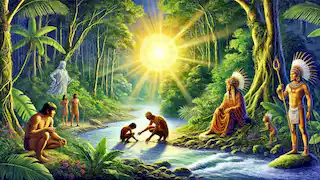The Story of the Tupi-Guarani Creation Myth
Reading Time: 6 min
About Story: The Story of the Tupi-Guarani Creation Myth is a Myth from brazil set in the Ancient. This Descriptive tale explores themes of Nature and is suitable for All Ages. It offers Cultural insights. Discover the divine tale of creation, resilience, and the eternal harmony of life in the Tupi-Guarani mythology.
In the heart of Brazil's dense Amazon rainforest, where the trees reach for the heavens and rivers twist like mythical serpents, the Tupi-Guarani people have long passed down a creation myth filled with wonder, wisdom, and profound spiritual meaning. This story reveals the origins of life, the divine beings who shaped the world, and the intricate web connecting all creatures. Rooted in oral tradition, this tale is as vibrant as the rainforest itself, echoing the harmony, challenges, and mysteries of existence. Before the Earth existed, there was nothing but an infinite void—an empty, silent expanse that was neither dark nor light, neither warm nor cold. Into this void came Tupã, the Great Spirit and creator of all things. Tupã was the source of divine energy, radiating power and light. Accompanying Tupã was his consort, Araci, the goddess of the dawn and fertility, whose beauty brought warmth to the lifeless void. Together, they descended upon a vast expanse of primordial waters, the only element that existed before the creation. Tupã raised his hands to the heavens and called forth the winds, the sun, and the stars, igniting life in the cosmos. This act marked the beginning of time and the creation of the world. Tupã shaped the land with his hands, forming great mountains, vast valleys, and flowing rivers. He scattered seeds across the fertile soil, and under Araci's nurturing care, lush forests sprang to life. Every tree, flower, and blade of grass bore the divine touch of Araci, who imbued the land with color and vitality. The sky, vast and endless, was adorned with stars by Tupã. Each star served as a guardian, watching over the Earth and its inhabitants. The moon and the sun were placed in their respective domains to govern night and day, ensuring the balance of light and shadow. Once the Earth was ready, Tupã and Araci created the first humans. From the clay of the riverbanks, Tupã molded a man and a woman, breathing life into them. These first humans, known as Rupave (Father of the People) and Sypave (Mother of the People), became the ancestors of all Tupi-Guarani people. Rupave and Sypave were gifted with the knowledge of the natural world, learning to live in harmony with their surroundings. They were taught to respect the forests, rivers, and skies, recognizing that all life was interconnected. Their descendants spread across the land, carrying the wisdom of Tupã and Araci with them. Tupã saw the need for balance and order in the world, so he created the Karaí, or sacred spirits, to protect the various realms of nature. Each Karaí had a specific domain: 1. Anhangá, the guardian of animals, ensured that hunters respected the balance of life and only took what was needed. 2. Jaci, the moon goddess, protected the night and watched over lovers and dreams. 3. Guaraci, the sun god, provided light and energy for growth. 4. Iara, the mermaid of the rivers, guarded the waterways and punished those who polluted or misused them. The Karaí were revered by the Tupi-Guarani, who offered rituals and prayers to maintain their favor and guidance. As with all creation myths, the Tupi-Guarani tale speaks of a struggle between forces of good and evil. Opposing Tupã was Anhanguera, the spirit of chaos and destruction. Anhanguera sought to undo Tupã's creations, sowing discord and misfortune among humans. Anhanguera brought diseases, storms, and droughts to the Earth, testing the resilience of Tupã's people. However, the humans, guided by the teachings of Rupave and Sypave, learned to overcome these hardships through unity and respect for nature. Each act of defiance against Anhanguera reaffirmed the strength of Tupã's creations. One of the most dramatic episodes in the Tupi-Guarani creation myth is the story of the great flood. Angered by humanity's occasional neglect of the sacred balance, Tupã sent torrential rains to cleanse the Earth. The floodwaters rose, swallowing entire forests and plains. Many humans and animals perished, but a chosen few were saved by a divine warning. Tupã instructed a wise elder, Sumé, to build a great canoe and gather a pair of each animal. As the rains subsided and the waters receded, Sumé and the survivors emerged into a renewed world. This event served as a reminder of the fragility of life and the importance of living in harmony with nature. Among the many creatures created by Tupã, the hummingbird holds a special place in Tupi-Guarani mythology. Known as the beija-flor, the hummingbird is a symbol of hope, love, and resilience. Legend says that the hummingbird was tasked with carrying messages between humans and the divine. When humans were in despair or needed guidance, they would watch for the hummingbird, believing its presence signified Tupã's blessing. Its ability to hover in place and dart swiftly was seen as a divine gift, bridging the earthly and spiritual realms. The Tupi-Guarani creation myth concludes with the notion of an eternal cycle. Life, death, and rebirth are interconnected, forming a continuous loop. Tupã and Araci's creations are not static but ever-evolving, adapting to the rhythms of the natural world. Rituals, dances, and songs became central to Tupi-Guarani culture, serving as both a celebration of life and a way to honor the divine. These traditions are passed down through generations, ensuring that the wisdom of the myth endures. The Tupi-Guarani creation myth is more than a story—it is a testament to the profound connection between humans and the natural world. It teaches respect, gratitude, and the importance of balance, values that remain relevant in today's world. As we reflect on this myth, we are reminded of the beauty and fragility of life, the power of unity, and the enduring legacy of the Tupi-Guarani people, whose voices continue to echo through the rainforests of Brazil. {{{_04}}}The Beginning of Time
The Formation of Earth and Sky
The Birth of Humanity

The Sacred Guardians of Nature
The Conflict of Light and Darkness

The Flood and the Rebirth
The Role of the Hummingbird

The Eternal Cycle
Conclusion

















